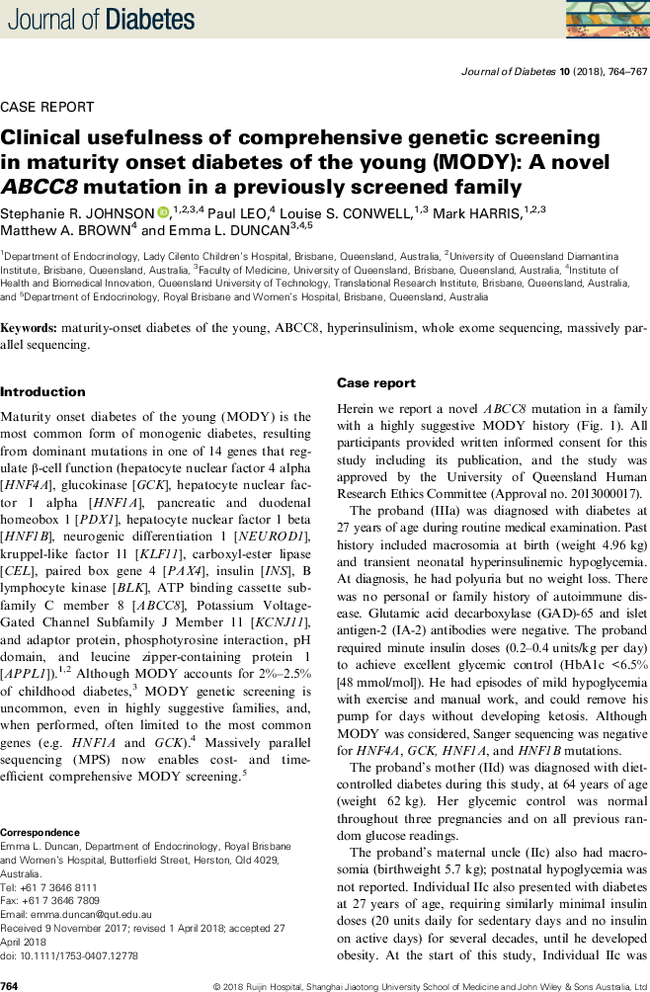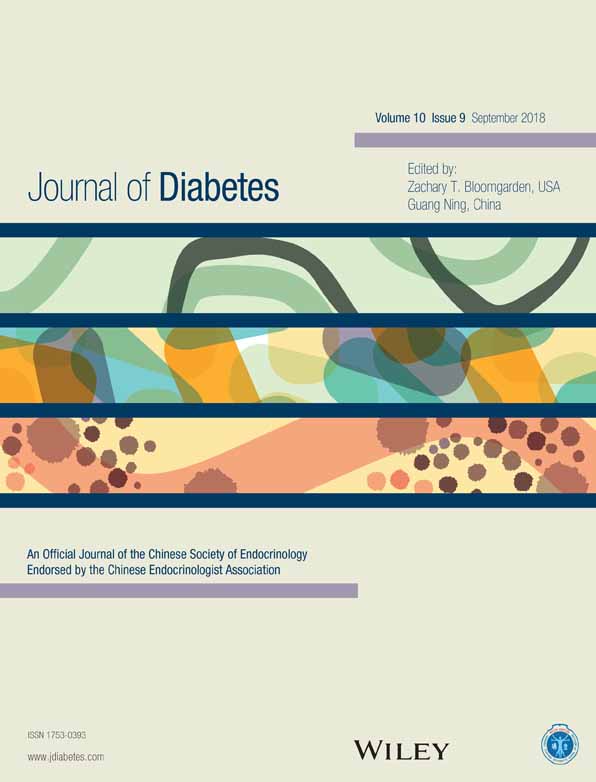Clinical usefulness of comprehensive genetic screening in maturity onset diabetes of the young (MODY): A novel ABCC8 mutation in a previously screened family
综合遗传筛查在青少年发病的成年型糖尿病(MODY)患者中的临床应用价值:在既往筛查过的一个家族中找到了一个新的ABCC8突变
Stephanie R. Johnson
Department of Endocrinology, Lady Cilento Children's Hospital, Brisbane, Queensland, Australia
University of Queensland Diamantina Institute, Brisbane, Queensland, Australia
Faculty of Medicine, University of Queensland, Brisbane, Queensland, Australia
Institute of Health and Biomedical Innovation, Queensland University of Technology, Translational Research Institute, Brisbane, Queensland, Australia
Search for more papers by this authorPaul Leo
Institute of Health and Biomedical Innovation, Queensland University of Technology, Translational Research Institute, Brisbane, Queensland, Australia
Search for more papers by this authorLouise S. Conwell
Department of Endocrinology, Lady Cilento Children's Hospital, Brisbane, Queensland, Australia
Faculty of Medicine, University of Queensland, Brisbane, Queensland, Australia
Search for more papers by this authorMark Harris
Department of Endocrinology, Lady Cilento Children's Hospital, Brisbane, Queensland, Australia
University of Queensland Diamantina Institute, Brisbane, Queensland, Australia
Faculty of Medicine, University of Queensland, Brisbane, Queensland, Australia
Search for more papers by this authorMatthew A. Brown
Institute of Health and Biomedical Innovation, Queensland University of Technology, Translational Research Institute, Brisbane, Queensland, Australia
Search for more papers by this authorCorresponding Author
Emma L. Duncan
Faculty of Medicine, University of Queensland, Brisbane, Queensland, Australia
Institute of Health and Biomedical Innovation, Queensland University of Technology, Translational Research Institute, Brisbane, Queensland, Australia
Department of Endocrinology, Royal Brisbane and Women's Hospital, Brisbane, Queensland, Australia
Correspondence
Emma L. Duncan, Department of Endocrinology, Royal Brisbane and Women's Hospital, Butterfield Street, Herston, Qld 4029, Australia.
Tel: +61 7 3646 8111
Fax: +61 7 3646 7809
Email: [email protected]
Search for more papers by this authorStephanie R. Johnson
Department of Endocrinology, Lady Cilento Children's Hospital, Brisbane, Queensland, Australia
University of Queensland Diamantina Institute, Brisbane, Queensland, Australia
Faculty of Medicine, University of Queensland, Brisbane, Queensland, Australia
Institute of Health and Biomedical Innovation, Queensland University of Technology, Translational Research Institute, Brisbane, Queensland, Australia
Search for more papers by this authorPaul Leo
Institute of Health and Biomedical Innovation, Queensland University of Technology, Translational Research Institute, Brisbane, Queensland, Australia
Search for more papers by this authorLouise S. Conwell
Department of Endocrinology, Lady Cilento Children's Hospital, Brisbane, Queensland, Australia
Faculty of Medicine, University of Queensland, Brisbane, Queensland, Australia
Search for more papers by this authorMark Harris
Department of Endocrinology, Lady Cilento Children's Hospital, Brisbane, Queensland, Australia
University of Queensland Diamantina Institute, Brisbane, Queensland, Australia
Faculty of Medicine, University of Queensland, Brisbane, Queensland, Australia
Search for more papers by this authorMatthew A. Brown
Institute of Health and Biomedical Innovation, Queensland University of Technology, Translational Research Institute, Brisbane, Queensland, Australia
Search for more papers by this authorCorresponding Author
Emma L. Duncan
Faculty of Medicine, University of Queensland, Brisbane, Queensland, Australia
Institute of Health and Biomedical Innovation, Queensland University of Technology, Translational Research Institute, Brisbane, Queensland, Australia
Department of Endocrinology, Royal Brisbane and Women's Hospital, Brisbane, Queensland, Australia
Correspondence
Emma L. Duncan, Department of Endocrinology, Royal Brisbane and Women's Hospital, Butterfield Street, Herston, Qld 4029, Australia.
Tel: +61 7 3646 8111
Fax: +61 7 3646 7809
Email: [email protected]
Search for more papers by this author
References
- 1Craig M. Monogenic diabetes: Advances in diagnosis and treatment. Medicographia. 2016; 38: 98–107.
- 2Prudente S, Jungtrakoon P, Marucci A et al. Loss-of-function mutations in APPL1 in familial diabetes mellitus. Am J Hum Genet. 2015; 97: 177–185.
- 3Shepherd M, Shields B, Hammersley S et al. Systematic population screening, using biomarkers and genetic testing, identifies 2.5% of the UK pediatric diabetes population with monogenic diabetes. Diabetes Care. 2016; 39: 1879–1888.
- 4Shields BM, Hicks S, Shepherd MH, Colclough K, Hattersley AT, Ellard S. Maturity-onset diabetes of the young (MODY): How many cases are we missing? Diabetologia. 2010; 53: 2504–2508.
- 5Ellard S, Lango Allen H, De Franco E et al. Improved genetic testing for monogenic diabetes using targeted next-generation sequencing. Diabetologia. 2013; 56: 1958–1963.
- 6McInerney-Leo AM, Marshall MS, Gardiner B et al. Whole exome sequencing is an efficient, sensitive and specific method of mutation detection in osteogenesis imperfecta and Marfan syndrome. Bonekey Rep. 2013; 2: 456.
- 7Flanagan SE, Patch AM, Mackay DJ et al. Mutations in ATP-sensitive K+ channel genes cause transient neonatal diabetes and permanent diabetes in childhood or adulthood. Diabetes. 2007; 56: 1930–1937.
- 8Babenko AP, Polak M, Cave H et al. Activating mutations in the ABCC8 gene in neonatal diabetes mellitus. N Engl J Med. 2006; 355: 456–466.
- 9Kapoor RR, Flanagan SE, James CT et al. Hyperinsulinaemic hypoglycaemia and diabetes mellitus due to dominant ABCC8/KCNJ11 mutations. Diabetologia. 2011; 54: 2575–2583.
- 10Huopio H, Otonkoski T, Vauhkonen I, Reimann F, Ashcroft FM, Laakso M. A new subtype of autosomal dominant diabetes attributable to a mutation in the gene for sulfonylurea receptor 1. Lancet. 2003; 361: 301–307.
- 11Dusatkova P, Pruhova S, Sumnik Z et al. HNF1A mutation presenting with fetal macrosomia and hypoglycemia in childhood prior to onset of overt diabetes. J Pediatr Endocrinol Metab. 2011; 24: 377–379.
- 12Kapoor RR, Locke J, Colclough K et al. Persistent hyperinsulinemic hypoglycemia and maturity-onset diabetes of the young due to heterozygous HNF4A mutations. Diabetes. 2008; 57: 1659–1663.
- 13Miki T, Tashiro F, Iwanaga T et al. Abnormalities of pancreatic islets by targeted expression of a dominant-negative KATP channel. Proc Natl Acad Sci USA. 1997; 94: 11969–11973.
- 14Kassem SA, Ariel I, Thornton PS, Scheimberg I, Glaser B. Beta-cell proliferation and apoptosis in the developing normal human pancreas and in hyperinsulinism of infancy. Diabetes. 2000; 49: 1325–1333.
- 15Bowman P, Flanagan S, Edghill E et al. Heterozygous ABCC8 mutations are a cause of MODY. Diabetologia. 2012; 55: 123–127.
- 16Riveline JP, Rousseau E, Reznik Y et al. Clinical and metabolic features of adult-onset diabetes caused by ABCC8 mutations. Diabetes Care. 2012; 35: 248–251.
- 17Rubio-Cabezas O, Hattersley AT, Njolstad PR et al. ISPAD Clinical Practice Consensus Guidelines 2014. The diagnosis and management of monogenic diabetes in children and adolescents. Pediatr Diabetes. 2014; 15 (Suppl. 20: 47–64.
- 18Klupa T, Kowalska I, Wyka K et al. Mutations in the ABCC8 (SUR1 subunit of the K(ATP) channel) gene are associated with a variable clinical phenotype. Clin Endocrinol (Oxf). 2009; 71: 358–362.
- 19Greeley SA, John PM, Winn AN et al. The cost-effectiveness of personalized genetic medicine: The case of genetic testing in neonatal diabetes. Diabetes Care. 2011; 34: 622–627.
- 20Shepherd M, Shields B, Ellard S, Rubio-Cabezas O, Hattersley AT. A genetic diagnosis of HNF1A diabetes alters treatment and improves glycaemic control in the majority of insulin-treated patients. Diabet Med. 2009; 26: 437–441.
- 21Shield JP. Neonatal diabetes: How research unravelling the genetic puzzle has both widened our understanding of pancreatic development whilst improving children's quality of life. Horm Res. 2007; 67: 77–83.
- 22Shepherd M. Transforming lives: Transferring patients with neonatal diabetes from insulin to sulphonylureas. Eur Diabetes Nurs. 2006; 3: 137–142.
10.1002/edn.60 Google Scholar
- 23Pearson ER, Flechtner I, Njølstad PR et al. Switching from insulin to oral sulfonylureas in patients with diabetes due to Kir6.2 mutations. N Engl J Med. 2006; 355: 467–477.
- 24McInerney-Leo AM, Marshall MS, Gardiner B et al. Whole exome sequencing is an efficient and sensitive method for detection of germline mutations in patients with phaeochromcytomas and paragangliomas. Clin Endocrinol (Oxf). 2014; 80: 25–33.




